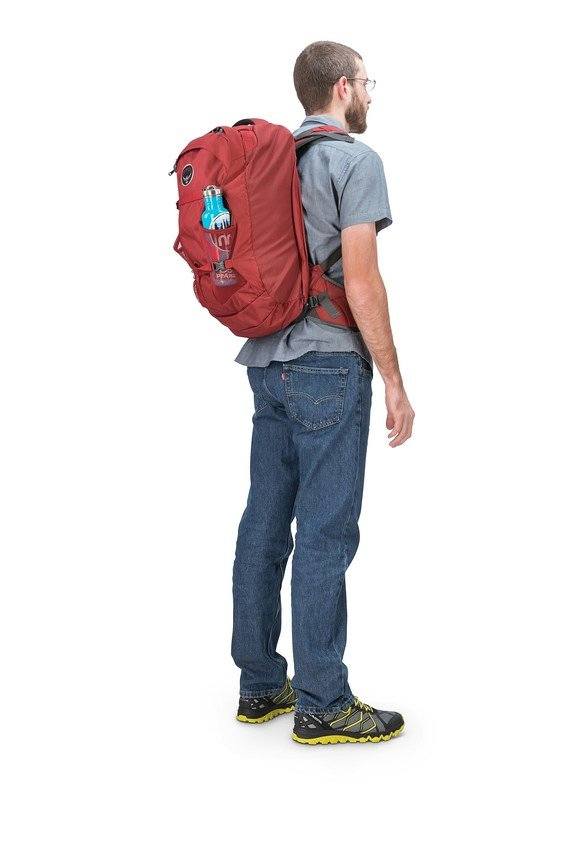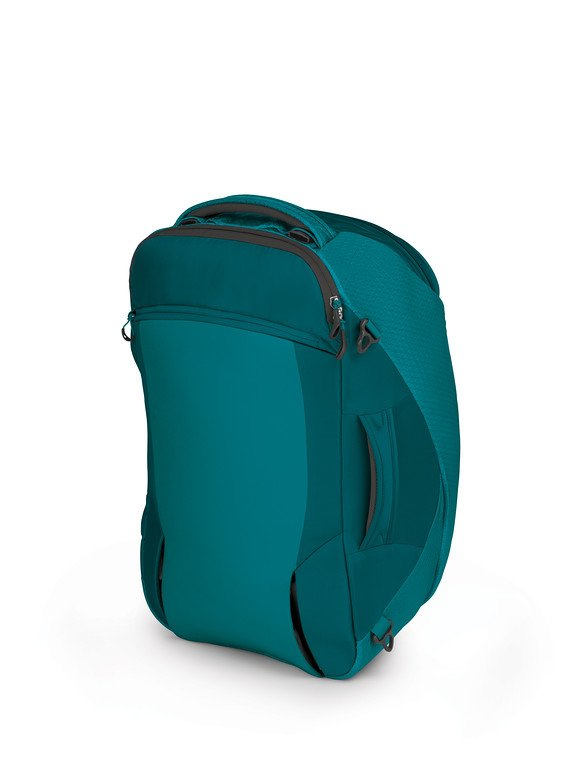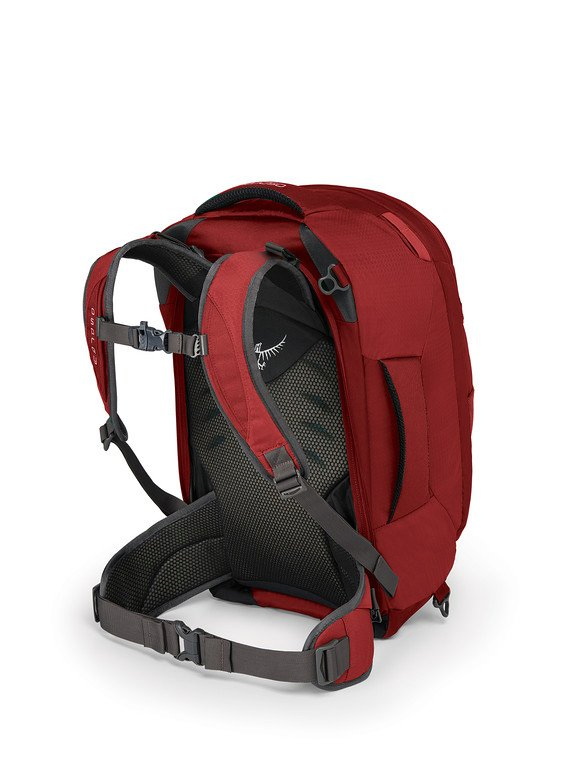When it comes to travel backpacks, carry-on compatibility, support, and storage space are three of the most sought after details.
We’ve matched up the Osprey Porter 46 vs Farpoint 40, both of which meet these standards.
To cut to the chase, the Osprey Porter 46 has the most travel perks. But, don’t count out the Farpoint 40 just yet.
Let us show you which backpack best fits your travel lifestyle, one detail at a time.
| IMAGE | PRODUCT&DETAILS | RATING | PRICE |
|---|---|---|---|
Osprey Porter 46 |
|||
Osprey Farpoint 40 |
Introducing the Osprey Porter 46
- Zippered top pocket provides easy access to toiletries and liquids
- U-zip full panel zip access to main compartment
- StraightJacket compression with padded sidewalls secures any size load effectively
Osprey is a highly trusted company that custom engineers outdoor backpacks to fit every need. They are highly praised for their ingenuity of design and care for the environment.
The Osprey Porter 46 stands out as a hybrid between a travel backpack and a deluxe duffel. Now you don’t have to choose between the two because Porter is both. With a solid compression system, useful storage space, and stow-away straps the Porter 46 is suitable for all types of travel.
Introducing the Osprey Farpoint 40
- Large, lockable U-zip duffel-style access to main compartment – 40L total volume
- Meets carry-on size restrictions for most airlines (Size Medium/Large: 21H X 14W X 9D inches)
- Lockable zipper access to padded laptop & tablet sleeve (fits up to most 15″ laptops)
- Stowaway backpanel, shoulder straps and hipbelt with zippered rear flap for protection
- Two front mesh waterbottle pocket
The beloved Osprey company has also designed the Farpoint series for travel and outdoor use.
The Osprey Farpoint 40 is simply engineered simply to meet your travel needs. Customer reviews confirm that the Farpoint series is simple but substantial. This is exactly why it’s one of the top-selling backpacks of it’s kind.
This bag stands out for its efficient design. With external and internal compression systems, duffel-like storage, and stowable straps the Farpoint 40 is reliable for both ground and air travel. Check our complete review of Farpoint 55.
Osprey Porter 46 vs Osprey Farpoint 40: Detailed Review

Design
The Osprey Porter 46 dimensions are 22H X 14W X 11D in inches. It holds 46 liters in capacity and weighs 3.4 pounds. The Osprey Porter 46 only comes in one size.
The Osprey Farpoint 40 comes in two different sizes. The small/medium size is measured at 20H X 14W X 8D inches, holds 38 liters, and weighs 3.11 pounds. The medium/large size measures in at 21H X 14W X 9D inches holds 40 liters and weighs 3.17 pounds.
Both packs are very similar in dimension/weight/capacity ratio. It’s nearly impossible to say one is better than the other in this category. However, the Farpoint 40 takes the win on this one because it allows you to choose from two sizes to find the most comfortable fit.
More: Kelty Redwing 44 VS Osprey Farpoint 40
Durability
The Porter 46 is primarily constructed with 420HD nylon packcloth. This material is lightweight, durable, and extremely water-resistant. The accent material and underside of this pack is a 420HD nylon wave ripstop to combat rips and tears.
The suspension system on the Osprey Porter 46 consists of an HDPE frame sheet. This specific suspension technology was designed to evenly spread the weight of your packs load across your entire body.
The main material on the Osprey Farpoint 40 is 210D nylon mini hex combined with diamond ripstop technology. In layman’s terms, this is a super lightweight, yet durable, material reinforced with tear-resistant stitching. If your backpack does get punctured, the ripstop technology will prevent the tear from lengthening.
The accent material, as well as the bottom material of the Farpoint, is made of 600D packcloth, which is a thick polyester found in the construction of most backpacks.
Osprey designed the Farpoint 40 with a 3.5mm LightWire peripheral frame and an Atilon frame sheet that distributes the load evenly across your body.
As a general rule of thumb, nylon is stronger than polyester and more water-resistant. The Porter’s 420 HD nylon, and nylon accent material, vs the Farpoint’s 210 nylon, and polyester accent material, dubs the Osprey Porter 46 our winner in the durability category.
Straps and Harnesses

The Osprey Porter 46 is designed with padded shoulder straps, a sternum strap, and a hip belt. These straps all stow-away by detaching and sliding into their respective compartments. When stowed, the back of the bag is completely smooth.
The sternum strap is adjustable and removable and has a built-in whistle. The hip belt is adjustable but not removable. It would seem as though you could still wear the pack, keeping the hip belt stowed. However, that is untrue because the shoulder straps need to be clipped to the hip belt when in use.
There are two large, padded handles on this pack: one on the top, and the other on the left-hand side when wearing the pack. These can be used for lifting the bag or carrying it like a briefcase.
Additionally, the Porter has built-in attachments for a shoulder sling strap, sold separately. This will come in handy if you prefer to carry your bag like a duffel.
The Osprey Farpoint 40 has all the same straps as the Porter 46, however, the Farpoint’s shoulder straps are slightly less padded. Additionally, the Farpoint comes with a thin shoulder sling strap included.
The Farpoint straps are also completely stowable. They do not stow into compartments like the Porter. Instead, the straps zip into the back panel by untucking a sleeve that is usually tucked near the underside of the pack.
Like the Porter, the hip belt on the Osprey Farpoint 40 is not removable.
These two packs are very similar in regards to their straps and harnesses. The Porter 46 offers slightly more padding, which gives it a leg up in this category.
More: Overview Of The Osprey Kamber 16 Daypack
Storage

The Osprey Porter 46 has a large main pocket for storage. The zipper is a large U-shaped zipper that allows you to access the contents of the bag like you would a duffle bag.
There are four other pockets on this bag. A small pocket is located at the top of the pack. This can be used for items you need easy access to, such as sunglasses, passports, wallets, etc. A medium-sized admin pocket is located in front of the main pocket, and a small vertically zipped pocket is designed into the very front of the pack.
Lastly, the laptop and tablet sleeve is its own pocket and is found at the very back of the pack.
The Osprey Farpoint 40 is designed very similarly to the Porter in terms of storage. There is one large pocket with a U-shaped zipper, one smaller tech pocket, and a small slash pocket.
There are only a couple of differences in terms of storage between the two bags. Number one, the Porter is larger in capacity by six liters, so its main pocket is noticeably bigger. Secondly, the Farpoint has two mesh water pockets on the exterior of the bag while the Porter has none. And lastly, the laptop sleeve on the Farpoint is located at the front of the pack instead of the back.
When I think of storage, I think capacity and organization. The Porter comes out on top with it’s larger packing space and pocket layout.
Compression
Both backpacks have two external compression straps that run horizontally across the front of the pack.
However, the Porter 46’s external compression system is much stronger than the Farpoint 40’s. The Porter uses a straight jacket compression system. It has an external shell that closes in on the pack as the compression straps are tightened. This feature allows you to pack more into the Porter than the Farpoint.
Both the Porter 46 and the Farpoint 40 are equipped with load-lifting straps located at the tops of the shoulder straps.
The Farpoint 40 has two internal compression straps to help secure your belongings. This is one feature that the Porter 46 lacks.
In short, the Osprey Porter 46’s compression system is more advanced than the Farpoint 40’s.
More: Osprey Kyte 46 Review
Laptop storage

The laptop sleeve in the Osprey Porter 46 is located at the back of the pack, close to your back when the backpack is on. It will easily fit a 15” laptop but is not quite large enough for a 17” laptop. Within the laptop compartment is a second, smaller padded compartment that fits a tablet.
The laptop pocket on this pack is extremely padded and protected. The pocket ends a few inches from the bottom of the pack to ensure your electronics are kept safe if the bag is dropped.
The Osprey Farpoint 40 is designed with the laptop sleeve near the front of the pack. This compartment will fit up to a 15” laptop. With that being said, the location of this laptop sleeve makes the backpack front-heavy when a laptop is packed inside.
If the pack is packed out, your laptop will probably stay protected if the bag were to be dropped on its front. However, the location of the pocket is not as safe as a posterior laptop pocket.
The placement and padding of the laptop sleeve in the Osprey Porter 46 is better than that of the Osprey Farpoint 40.
Breathability
The Farpoint 40 has better ventilation and breathability than the Porter 46.
The material on the back panel of the Porter is heavy-duty and compact, meaning it isn’t very porous. The shoulder straps do have a mesh material on the underside, but it doesn’t compare to the Farpoint.
The Farpoint is very visibly ventilated. Just by looking at the back panel you can see that it was designed with airflow in mind. The foam pad within the back panel has several slashes cut out to aid in airflow. And, the mesh material used on the back panel, the shoulder straps, and the hip belt is extremely ventilated.
More: Check our Guide to Best Osprey Backpack Here
Warranty
Both bags are covered under Osprey’s All Mighty Guarantee. This guaranty ensures that Osprey will “repair any damage or defect for any reason free of charge – whether it was purchased in 1974 or yesterday.”
Keep in mind, this guaranty is only applicable to purchases made directly on the Osprey website.
Versatility
The Osprey Porter 46 and the Osprey Farpoint 40 are both marketed as travel backpacks. Both packs were engineered with technology and design features geared toward traveling. This makes them exceptional for long trips like international touring.
However, we understand the desire to find one go-to bag that will fit most recreational needs.
The Porter 46 can conveniently compress and clip into a condensed version of itself. This adds an element of versatility to the pack. However, it is slightly heavier and longer than the Farpoint 40.
We like the simplicity of the Osprey Farpoint 40 that allows you to use it how you like. It is extremely versatile. You can use it as a carry-on, a day pack, or a school backpack. You can even take it out mountain biking, snowboarding, or rock climbing.
The smaller size and simple design of the Osprey Farpoint 40 make it more versatile than the Osprey Porter 46.
More: Osprey Kestrel 38 Review
Stand Out Features of the Osprey Porter 46
Shell

The outer shell on the Porter 46 is a key feature of this pack. It is designed to effectively compress your pack, so that you can pack more. This is especially helpful when using this backpack as an airplane carry on bag. This is exactly why Osprey markets the bag as the Porter 46 carry on.
In addition, the shell provides the pack with some level of versatility. Not only does it aid in packing more into the back, but it also comes in handy when the backpack is not packed full.
There are two clips on the side of the pack, in line with the compression straps. When needed, you can compress the shell and clip the straps to these second attachments. This will greatly reduce the size of the bag and secure your belongings inside.
The value of this shell doesn’t end there. It also acts as a wall when the pack is unzipped. This allows you to get to your things without them falling out of the pack. With this outer shell as a stabilizer, you can even dig around to find what you need without creating a mess.
Daylite Accessory Pack Compatibility
Another valuable feature of the Osprey Porter 46 is its compatibility with the Osprey Daylite accessory pack. The Daylite is a smaller travel bag that is often used for errands or day hikes.
The Porter has four small attachment points located near the corners of the compression straps. These are designed to hook the Daylite pack onto the Porter. This allows for easy transitions between activities like long and short hikes.
Vertical Zip Pocket
The vertical zip pocket on the very front of the Osprey Porter 46 was designed with accessibility in mind. Specifically, its purpose is to store toiletries and liquids for quick access. This will help save time at airport security when you need to unpack and present your liquids. And, it will keep these items handy while out and about.
Stand Out Features of the Osprey Farpoint 40

Included shoulder strap
Both the Porter and the Farpoint come with shoulder sling strap attachments. However, the Farpoint actually comes with a shoulder strap included. Albeit very basic in design, the shoulder strap gives this bag more carry options without the added cost.
Soft Lined Small Pocket
The small stash pocket at the front of the Osprey Farpoint 40 is lined with a soft material. This special material was designed into the pack specifically to keep your sunglasses from scratching.
Hideable Hip Belt
Like we mentioned before, the hip belt on the Farpoint 40 is not removable. This can be an annoyance on the days where you don’t need or want the extra hip support. Some people have found a way around this by hiding the hip belt. You can do this by tucking it into the stow-away sleeve located on the underside of the pack.
Which is Better, Osprey Porter 46 or Osprey Farpoint 40?
So which is best, Porter 46 or Farpoint 40? The answer is they’re both phenomenal. It really comes down to what you want to use the bag for.
Use the Osprey Farpoint 40 if:
- You’re looking for a sleek and simple design
- You want external water bottle pockets
- You need a pack with good ventilation
- You’re looking for standard carry-on size
Use the Osprey Porter 46 if:
- You need day pack attachments
- You need as much space as possible in your carry-on
- You need versatility in the capacity of your pack
- You’re looking for a larger travel backpack
Although both of these backpacks are very similar in design and functionality, they both tailor to different needs. If you’re looking for a travel backpack suitable for in the air and on the ground travel, you will be sure to find the perfect fit in one of these two designs.







